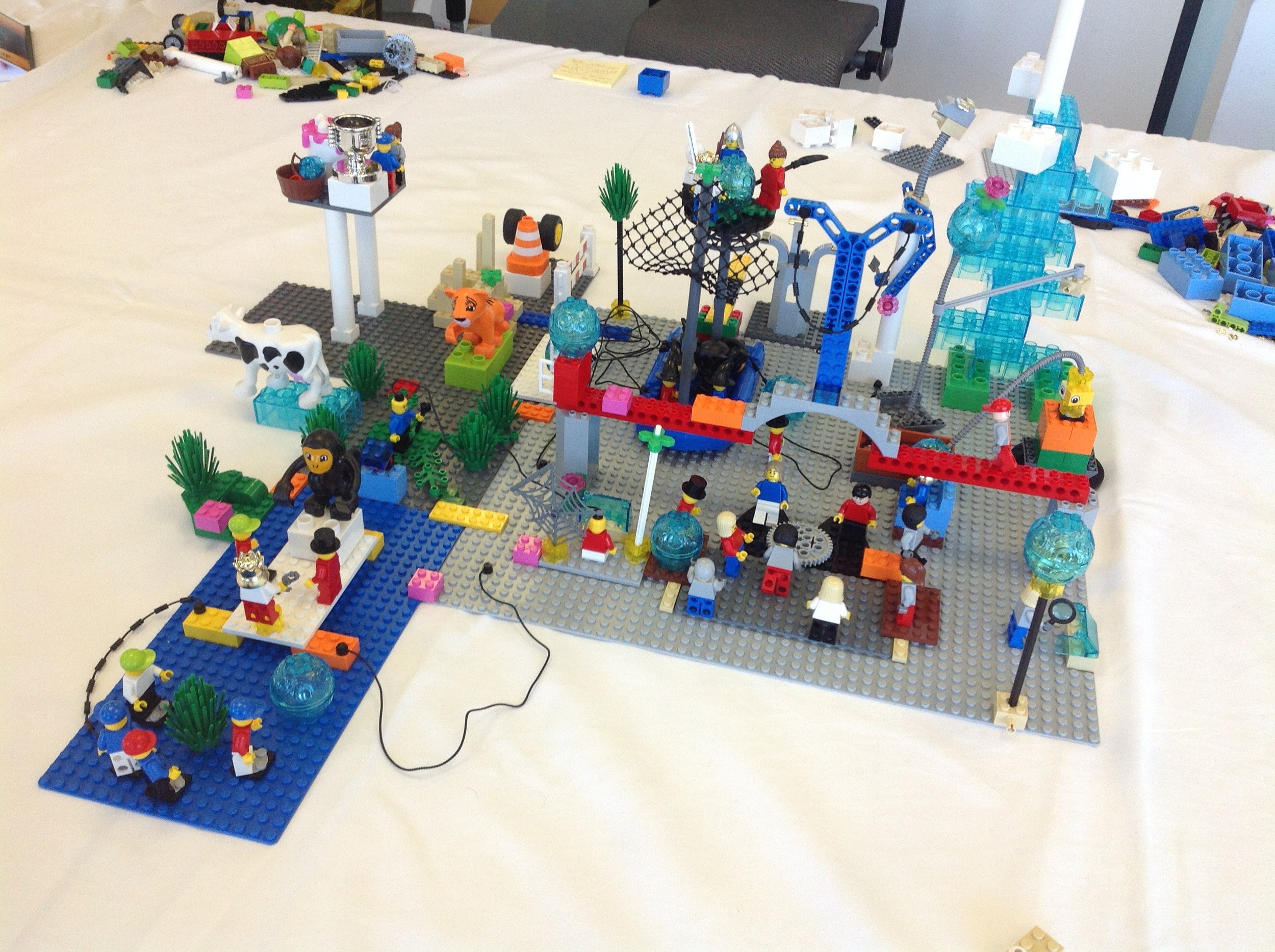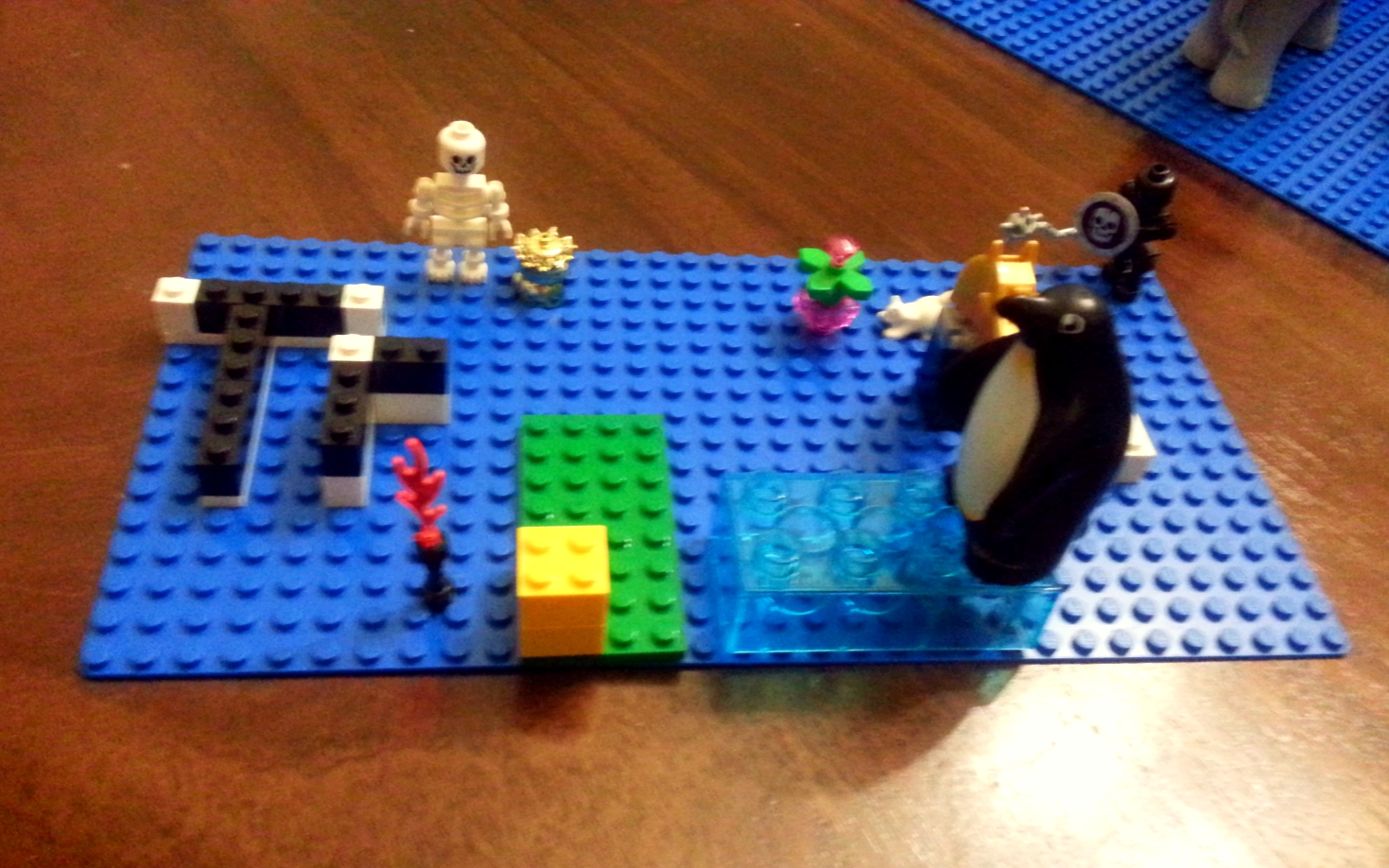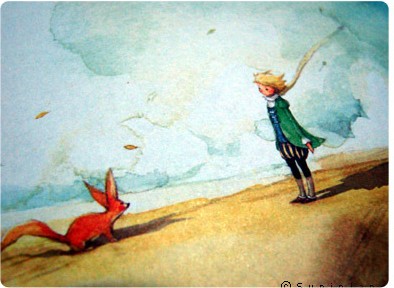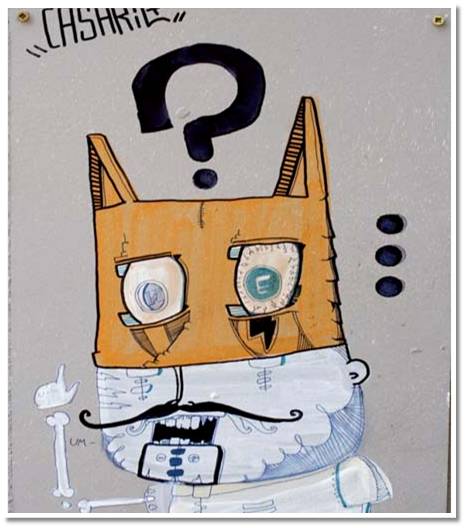Insights from a Lego Practitioner on the Power of Play
 One of the more significant challenges facing organisations is the question of how to develop effective organisational learning in volatile trading markets. In a world where questions can potentially be more powerful than answers, what does learning look like? If an agile workforce understands the importance of questions over answers, prototyping and iterating potential solutions and developing a healthy appreciation for problem finding when it comes to working on the right problem, what if anything needs to change in the way we do organisational design?
One of the more significant challenges facing organisations is the question of how to develop effective organisational learning in volatile trading markets. In a world where questions can potentially be more powerful than answers, what does learning look like? If an agile workforce understands the importance of questions over answers, prototyping and iterating potential solutions and developing a healthy appreciation for problem finding when it comes to working on the right problem, what if anything needs to change in the way we do organisational design?
 What I have observed from running strategy sessions using LEGO® SERIOUS PLAY® as a methodology is that Building requires a different starting point. Much of my work in Leadership Development has focused on reflection as the critical stance. With LEGO® SERIOUS PLAY® I have noticed something different happening. What I have found is that when one builds, one moves into a space of Play and that ego seems to fall away. What I mean by this is that due to the nature of the Lego blocks holding no inherent meaning, because one can eliminate things, break things down and rebuild, it seems to eradicate the place of judgement around oneself and ones ability to think through challenges.
What I have observed from running strategy sessions using LEGO® SERIOUS PLAY® as a methodology is that Building requires a different starting point. Much of my work in Leadership Development has focused on reflection as the critical stance. With LEGO® SERIOUS PLAY® I have noticed something different happening. What I have found is that when one builds, one moves into a space of Play and that ego seems to fall away. What I mean by this is that due to the nature of the Lego blocks holding no inherent meaning, because one can eliminate things, break things down and rebuild, it seems to eradicate the place of judgement around oneself and ones ability to think through challenges.
It is my belief that the constructionist nature of Lego helps to develop a capacity for leaders to work in a state of emergence and harness Play as a powerful driver for organisational learning.
 The answer always lies in the system you are building. Thus it creates a place for multiple perspectives to emerge and to be assessed without judgement. Doing these sessions has profoundly changed the way I view learning - I understand now from the impact I have seen in the thinking of the people I have worked with that it is not only in reflection that we learn but in Play, that we create and grow.
The answer always lies in the system you are building. Thus it creates a place for multiple perspectives to emerge and to be assessed without judgement. Doing these sessions has profoundly changed the way I view learning - I understand now from the impact I have seen in the thinking of the people I have worked with that it is not only in reflection that we learn but in Play, that we create and grow.
I will be talking about the Power of Play at the Knowledge Resources Chief Learning Officers conference in Johannesburg and giving a free talk on 25th October at Creative Mornings in Cape Town.
What Curiosity Isn't
 Curiosity is increasingly being touted as a critical 21st leadership practice for business leaders. Curious leaders are able to better mitigate risk, more willing to be open to the diverse opinions of others, frame and reframe alternative perspectives when it comes to decision making. In short, curious leaders as able to better access their agility - so important for leaders today in a world where attempting to going faster than the rate of change has proven to be a fruitless and ineffectual practice.
In the charge to fuel organisations full of curiosity, certain assumptions have been made which I would like to challenge. I would like to delineate three things which are often incorrectly ascribed to the notion of Curiosity. Highlighting their importance will perhaps go some way in revealing why curiosity is an important trait to nurture in adults.
Curiosity is increasingly being touted as a critical 21st leadership practice for business leaders. Curious leaders are able to better mitigate risk, more willing to be open to the diverse opinions of others, frame and reframe alternative perspectives when it comes to decision making. In short, curious leaders as able to better access their agility - so important for leaders today in a world where attempting to going faster than the rate of change has proven to be a fruitless and ineffectual practice.
In the charge to fuel organisations full of curiosity, certain assumptions have been made which I would like to challenge. I would like to delineate three things which are often incorrectly ascribed to the notion of Curiosity. Highlighting their importance will perhaps go some way in revealing why curiosity is an important trait to nurture in adults.
Firstly,
Curiosity is not the same as Wonder Despite the importance of Curiosity as an impactful leadership practice in one's business strategic leadership armoury, many organisations have been wary of bringing curiosity into their company culture. The argument is that curious workers will become even more distracted then they currently are. This is based on the faulty assumption that wonder and curiosity are the same thing.
Embracing wonder is what will send one down a rabbit hole and spiral you into overload. Awe is about the general whilst Curiosity is always about the particular. Curiosity, according to George Loewenstein is what emerges when there is a mental object that exists out in the world that purports a different way of perceiving what your mental models states as the fact of a thing. When your mental model is disrupted, you have one of two choices. You can either suspend disbelief and become curious or you can reject the alternative out of hand and remain with your way of seeing and doing.
An example that I think clearly makes the point is the one which relates to bones in a human. If I were to give you two sets of numbers - 305 and 206 - perhaps the only thing you might find vaguely interesting is the fact that they both equal 8 if you had to do a calculation. But what if I gave you a context - what if I were to say to you that these are the number of bones in a child’s body and an adult's body? Then perhaps your curiosity might be piqued. Your mental model of the world has probably decided that when we are borne we are given a set of bones which remain unchanging over time unless there is an accident or operation. You could choose to dismiss this assertion and continue to operate in the world under your own assumption or you could ask, “Why?”. This questioning is curiosity in its essence. The answer is that bones fuse over time.
Curiosity is a critical lens to help focus our attention on that which we are disrupted by, and that which remains incongruent in terms of our world view. Curiosity is what causes us to challenge the way we see things and genuinely become interested in the opinions and views of others. It also helps us to see other possibilities. It is also a marker to challenge us when we rely, because of pressure of time, on the two or three models we have been taught to solve whatever problem is in front of us.
Curiosity is an Adult trait
According to Steven Dutch, children are tinkerers. It is worth quoting his insight in full: "The commonplace observation that children have short attention spans is direct refutation of the notion that they are creative and curious in any deep sense. The tragedy of our society is not that so many people outgrow their childlike curiosity, but that so few do. The adult equivalent of childlike curiosity is channel surfing and the ten-second sound bite". In order to be curious, one needs to have one's mental models disrupted within a context. Children spend their formative years building those models through repetition and tinkering. It is only once those mental models have been established that they can be disrupted. Far from the popular belief that Curiosity is steadfastly beaten out of us as children, it is as adults that we stop being curious once we have worldviews that we decide on and find more convenient not to have changed.
Curiosity didn't Kill the Cat
I cannot begin to count the times that people quip at me about cats when I speak about Curiosity. In fact Curiosity didn't kill the cat. The notion of Curiosity emerged etymologically in the 14th century as synonymous with Care. So when it is spoken of that Curiosity killed the cat, what is being referred to is Care, that too much care will smother things, the usage of a cat because it is one of the least interested of the animal kingdom in too much fussing.
To develop Curiosity as a practice, we need to accept responsibility for the fact that it is an adult trait, an appreciating asset that grows over time with use. It is your conscious role in seeking out things that disrupt your worldview through exploring other disciplines and insights that will challenge how you see the world and help you change it.
Play as a Design Tool for Leadership Development
 It has been shown in Australian business that only 58% goes on work that adds “real value” to organisations, with the inefficiencies costing business $109 billion in wages every year.
The figures are, I have no doubt, similar in South Africa. In fact, according to the World Competitiveness Yearbook (2012), South Africa is rated 50 amongst 59 countries. When more than half of our time is spent on solving the wrong problem, surely it is time to try a different methodology?
It has been shown in Australian business that only 58% goes on work that adds “real value” to organisations, with the inefficiencies costing business $109 billion in wages every year.
The figures are, I have no doubt, similar in South Africa. In fact, according to the World Competitiveness Yearbook (2012), South Africa is rated 50 amongst 59 countries. When more than half of our time is spent on solving the wrong problem, surely it is time to try a different methodology?
It is frequently the case that in instructional design, a ‘red thread’ or programme director is used as the touchstone of meaning making in an organisational or leadership development process. Although this a fair way to increase the sensemaking and to develop the emergent outcomes (outcomes that only begin to appear once processes and conversations have begun), it is not enough to ensure we are focusing on the right problems.
I am currently in the middle of a MOOC on Creative Learning being run by MIT and there is an insight which I want to share. Mitchel Resnick argues that the pattern of learning in Kindergarten children are ideally suited to the needs of the 21st century.
The process that he has observed in children when they learn involves six moments: 1) Imagine 2) Create 3) Play 4) Share 5) Reflect 6) Imagine (again)
With my interest in Curiosity as a critical leadership development tool and the knowledge that we often focus on the wrong problems, I decided to experiment with his insights and used this process as a basis for the design of a one day Leadership Masterclass on Agility. I have just run it in Melbourne, Australia. Here is an example of one of the sessions in the day using Play as a design tool, matching exercises I would otherwise have run in a different order now in the structure of Play:
Imagine: X BELIEVES THE WORLD WOULD BE A BETTER PLACE IF... Create: CHOOSING THE RIGHT PROBLEM TO WORK ON Play: SPEEDBOAT CHALLENGE Share: POWERFUL QUESTIONS Reflect: CHOOSE ONE TO WORK ON AND WHY Imagine: IF YOU COULD CHANGE YOUR LIMITING BELIEFS WHAT WOULD BE DIFFERENT - WALKING THINKING PARTNERSHIP
What felt different from this workshop to any other I had run was the investment by the participants and the amount of laughter it generated. Kindergarten kids laugh 250 times a day. Middle aged people laugh 15 times a day. We spend so much time trying to do everything and doing it faster and not enough time laughing, reflecting, enjoying, and focusing on the important. However, it was not only laughter it generated. Using Play as the basis for a structure really helped us get to the nub of some of the complex issues in a way which did not feel fearful. Instead it generated a depth and a focus for tackling serious problems that felt had ease and congruence.
From the experience of using Play as a design tool, it is my contention that PLAY has a profoundly important role to play when it comes to identifying, tackling and solving 21st Century problems in the world of Business, Government and Education.
The Gratitude for Fathers
 My blog over the last six years has mainly been about sharing wisdom from the world of work and insights from those environments. This post is a little different. It is about acknowledgement and connection - things I am beginning to realise are far more important in leadership development than pontificating. I have left secure jobs often over the years - for many reasons - mainly because I have been passionate about pursuing new things. It is the one year anniversary of my own business. I want to write this post today in gratitude of my father. He taught me when I was very little about the Fox and the Little Prince - made me believe very deeply in the idea that you are responsible for what you tame. I have worked in prisons, with young people in care, with accelerating those in disadvantaged positions for leadership roles, those in the advantaged for even greater heights. I am passionate about Curiosity and Agility, about Bravery and Courage. It has defined the work I do and the work I have stopped doing. My father doesn't have legs. He lost them both to Diabetes. But he continues to drive my belief in myself - sometimes when running your own business isn't easy, when you worry more about money than ideas. I want to thank him for always making me remember that Education is about teaching people how to think, not what to think. It has informed everything I do. When I was 21, he read me a poem by J.P. Cavafy.
Ithaka
My blog over the last six years has mainly been about sharing wisdom from the world of work and insights from those environments. This post is a little different. It is about acknowledgement and connection - things I am beginning to realise are far more important in leadership development than pontificating. I have left secure jobs often over the years - for many reasons - mainly because I have been passionate about pursuing new things. It is the one year anniversary of my own business. I want to write this post today in gratitude of my father. He taught me when I was very little about the Fox and the Little Prince - made me believe very deeply in the idea that you are responsible for what you tame. I have worked in prisons, with young people in care, with accelerating those in disadvantaged positions for leadership roles, those in the advantaged for even greater heights. I am passionate about Curiosity and Agility, about Bravery and Courage. It has defined the work I do and the work I have stopped doing. My father doesn't have legs. He lost them both to Diabetes. But he continues to drive my belief in myself - sometimes when running your own business isn't easy, when you worry more about money than ideas. I want to thank him for always making me remember that Education is about teaching people how to think, not what to think. It has informed everything I do. When I was 21, he read me a poem by J.P. Cavafy.
Ithaka
As you set out for Ithaka Hope your journey is a long one Full of adventure, full of discovery. Laistrygonians, Cyclops Angry Poseidon – don’t be afraid of them: You’ll never find things like that on your way As long as you keep your thoughts raised high, As long as a rare sensation touches your spirit and your body.
Laistrygonians, Cyclops, Wild Poseidon – you won’t encounter them Unless you bring them along inside of your soul Unless your soul sets them up in front of you.
Hope your road is a long one. May there be many summer mornings when, With what pleasure, what joy, You enter harbours seen for the first time; May you stop at Phoenician trading stations To buy fine things Mother of pearl and coral, amber and ebony, Sensual perfumes of very kind- As many sensual perfumes as you can; And may you visit many Egyptian cities To learn and to go on learning From those who do know.
Keep Ithaka always in your mind. Arriving there is what you are destined for. But don’t hurry the journey at all. Better if it lasts for years. So you’re old by the time you reach the island, Wealthy with all you will have gained on the way. Not expecting Ithaka to make you rich.
Ithaka gave you the Marvellous journey. Without her you wouldn’t have set out. She has nothing left to give you now. And if you find her poor, Ithaka won’t have fooled you. Wise as you will have become, so full of experience, You’ll have understood by then what these Ithakas mean.
JP Cavafy
It informs my life till today. I did not understand at that time what it could mean to disappoint. I understand now that perceptions of disappointment come from many different places; from the context and the history every person brings to the understanding of their current experience. There is no one person who has a net wide enough to hold everyone. It has taken me decades to separate out my stuff from other people's stuff. But your wisdom has held me for over forty years, Daddy.
Thank you, Professor Frank Cecil Henley Rumboll. You rock my world.
The Agile Leader's Toolkit
 For deep sustainability to have legs, teeth and even hair, we need an organisational ethos which promotes fluidity and adaptability. There has been much talk of the current need for agility in organisations and according to McKinsey how in the next five years it will become even more critical. But what exactly is Agility and as a leader how do you practice it? To my mind, the notion of Agility is an umbrella term for a set of leadership capabilities that I think serve as a prerequisite for developing high impact leadership practices today.
Counter to popular belief, one does not match the speed of the environment by trying to “just go faster”. An agile leader does not respond to a faster moving business environment by trying to match the speed thereof. Instead they work with a different order of things, finding ways to adjust their own behaviour and perspective. As Rumi said, “Yesterday I was clever, so I wanted to change the world. Today I am wise, so I am changing myself”. Agile leaders are leaders who are able to reflect, see possibilities and reframe their thinking constantly. They understand the importance of adaptability, grace in failure, curiosity, collaboration, back up, diversity, ease of access and the ability to forecast. By slowing down to build the practices which deliver results in today’s environment they are able to match the pace required.
For deep sustainability to have legs, teeth and even hair, we need an organisational ethos which promotes fluidity and adaptability. There has been much talk of the current need for agility in organisations and according to McKinsey how in the next five years it will become even more critical. But what exactly is Agility and as a leader how do you practice it? To my mind, the notion of Agility is an umbrella term for a set of leadership capabilities that I think serve as a prerequisite for developing high impact leadership practices today.
Counter to popular belief, one does not match the speed of the environment by trying to “just go faster”. An agile leader does not respond to a faster moving business environment by trying to match the speed thereof. Instead they work with a different order of things, finding ways to adjust their own behaviour and perspective. As Rumi said, “Yesterday I was clever, so I wanted to change the world. Today I am wise, so I am changing myself”. Agile leaders are leaders who are able to reflect, see possibilities and reframe their thinking constantly. They understand the importance of adaptability, grace in failure, curiosity, collaboration, back up, diversity, ease of access and the ability to forecast. By slowing down to build the practices which deliver results in today’s environment they are able to match the pace required.
I have developed a toolkit which I hope could serve as a checklist for organisations who are interested in constructing sustainable leadership practices in their organisations - a sustainability which is both palpable in the conversations which their employees have but one which also drives the operations and the decision making processes their leaders engage in daily.
In order to build Agility into the DNA of one's leadership practice, there are nine things which I think are required. I have tried to list these from A-I for ease of reference:
Adaptability Back Up Curiosity Diversity Ease of Access Foresight Grace in Failure Hubs Inclusiveness
Adaptability (Flexibility): We need to be ready to change our plans when they are not working the way we expected. In a world where the rate of change happens faster than our ability to respond to it, how do we change course mid direction? We need to build a healthy robustness around how we are going to react. We can no longer count on things remaining stable. The question is how have you created alternatives for yourself.
Sappi for me, is an interesting case in point. The largest producer of coated fine paper in the world, when faced with a downward trend in their market, went out and bought the second biggest producer. Instead of genuinely engaging with what they could do differently, there seems to be an embracing of more of the same. It has not helped to bolster their share price. The reality is, that it is no longer the survival of the fittest but those who are more able to be responsive to change who survive. What are the ways in which you can nurture your own ability to adapt? Bruna Martinuzzi is worthwhile reading on some quick wins on developing your own adaptability.
Backup (Redundancy): Backup, backup, backup. Perhaps the cardinal rule for an agility based economy is to never leave yourself with just one path of escape or rescue. Eskom, our very own generator of approximately 95% of electricity in South Africa, is a case in point. Faced with a backload of energy shortfall, Eskom has taken on a US$3.5 billion debt to the World Bank to build a coal smelter - which is teneted on old technology and directly generates disastrous environmental consequences for us. Says South African professor Patrick Bond: "South Africa's five-fold increase in CO2 emissions since 1950 and 20% increase during the 1990s, can largely be blamed upon the attempt by state electricity company Eskom, the mining houses (led by Anglo American) and huge metals smelters (especially BHP Billiton) to brag of the world's cheapest electricity. Emitting 20 times the carbon tonnage per unit of economic output per person than even the United States, South African capital's reliance upon fossil fuels is scandalous." A quick solution based on an immediate gratification but one which I believe will have long term implications for our labour market and export sector. Failure to back up in the demand side of their business has resulted in an economic debt which will have dire social implications.
 Curiosity
Curiosity cues our attention. It provides a lens for what we focus on. It emerges when the mental model we use currently is disrupted. One may have one of two responses - judgement or curiosity. Judgement will shut down new possibilities whereas curiosity will allow one to see other alternatives. As it requires that one’s way of seeing be challenged it more often than not demands that we look outside of the discipline we know to see other alternatives. According to Todd Kashdan (2009), lack of curiosity is a breeding ground for stereotyping and discrimination, inflated confidence and ignorance that can lead to poor decision making, dogmatism and rigidity of thought. An agile leader is a curious leader.
Curiosity
Curiosity cues our attention. It provides a lens for what we focus on. It emerges when the mental model we use currently is disrupted. One may have one of two responses - judgement or curiosity. Judgement will shut down new possibilities whereas curiosity will allow one to see other alternatives. As it requires that one’s way of seeing be challenged it more often than not demands that we look outside of the discipline we know to see other alternatives. According to Todd Kashdan (2009), lack of curiosity is a breeding ground for stereotyping and discrimination, inflated confidence and ignorance that can lead to poor decision making, dogmatism and rigidity of thought. An agile leader is a curious leader.
Diversity: If you don't rely on a single kind of solution, you won't suffer from a single point of failure. This is perhaps the greatest and most significant contribution South Africa, as a nation can offer. After all, it is embedded into our ecolological DNA. Take Fynbos. In the Western Cape alone, there are 2200 species on Table Mountain. They coexist harmoniously and if after 8 years, if they don't experience fire, they die. Multiple perspectives allow multiple entry and exit points to challenges we are facing. If we don’t face the fire of our judgement and opinions the likelihood of them surviving is questionable. And perhaps the measure should be having your ideas questioned every 8 hours rather than every 8 years.
Ease of Access: Don’t hide your systems-transparency makes it easier to figure out where a problem may lie. Share your plans and preparations, and listen when people point out flaws. I think Michael Jordaan of FNB is a shining example of this. As the CEO of one of the biggest banks in South Africa he has an active Twitter presence where he can share new developments in his market and quell fears regarding network breakdowns. The downside is that I have seen him have to be online at close to midnight giving systems updates and gets asked questions like what is the branch code for little known areas> However what  this ease of access has allowed is for FNB to stand out as a pioneer in what the worth of transparency is and what it can do for your brand.
this ease of access has allowed is for FNB to stand out as a pioneer in what the worth of transparency is and what it can do for your brand.
Foresight: As Nassim Taleb said, if we only knew how closely the word ‘prophecy’ and ‘foresight’ were aligned in Semitic languages we would be less confident about our abilities in that arena. You can’t predict the future. But as Bobby Godsell wisely said, “you can hear its footsteps approaching”. Think and prepare. It reminds me very strongly of the Truth & Reconciliation Commission set up in South Africa post independence. Nobody knew what the fallout of a devastating system of oppression would be, but introducing a systemised process which allowed people to share their stories in some small way eased a piece of the enormous burden of this history. The question to ask is what sort of practice can you build into your own leadership behaviour which builds an awareness of the foresight which might be required as an agile leader?
Grace in Failure: Failure happens, so make sure that a failure state won’t make things worse than they are already. In fact according to Thomas Watson, founder of IBM, "If you want to succeed, double your failure rate". The story of Mxit has always been an inspirational one for me. The genesis of Mxit was a multi player gaming platform. Scripts had been developed, actors cast. When tested with their user base the overwhelming response was that people wanted a place to talk and share on mobile. Instead of fighting the need, the developers humbly listened to their followers and built what has become the largest social network in Africa.The acceptability of this is so common now that Silicon lexicon has introduced a word called Pivoting for it. What you start with will probably not be what you end up with. Instead of seeing this as a failure it is instead a sign that you are on the right track.
Hubs (Decentralization): Centralized systems look strong, but when they fail, they fail catastrophically. The recent rumblings of consolidating all the provinces into one centralised system strikes somewhat of a warning bell. There has been much debate around the value of matrix organisations and decentralised units. What allows a decentralised system to perform is when it has a centralised node of trust. Agility demands that there been an alignment between principle and action. Centralisation without trust is a potentially catastrophic fail.
 Inclusiveness (Collaboration): The reality is that we are all in this together. Take advantage of collaborative technologies, especially those offering shared communication and information. I think the open source operating system built from Linux core architecture called Ubuntu led by SA tech billionaire Mark Shuttleworth is an inspiration. The open source approach enables the OS to develop in line with the market needs, as it develops and grows through various contributing developments and thus 'scratching their own nearby itch'. Although the software is free, the premium offerings , like IBM come at a fee. This collaborative, 'the more you share, the more you win' approach has generated extraordinary results for both business and education. Coursera is another exciting new development with a host of Ivy league schools in the States creating 123 free online offerings by seasoned academics like Dan Ariely whose course on Irrational Behaviour I look forward to taking in March 2013.
Inclusiveness (Collaboration): The reality is that we are all in this together. Take advantage of collaborative technologies, especially those offering shared communication and information. I think the open source operating system built from Linux core architecture called Ubuntu led by SA tech billionaire Mark Shuttleworth is an inspiration. The open source approach enables the OS to develop in line with the market needs, as it develops and grows through various contributing developments and thus 'scratching their own nearby itch'. Although the software is free, the premium offerings , like IBM come at a fee. This collaborative, 'the more you share, the more you win' approach has generated extraordinary results for both business and education. Coursera is another exciting new development with a host of Ivy league schools in the States creating 123 free online offerings by seasoned academics like Dan Ariely whose course on Irrational Behaviour I look forward to taking in March 2013.
We live in a world with high degrees of complexity, uncertainty and inequality. In order to be able to do effective, meaningful and impactful work we require a different set of leadership practices. I would be curious to hear about some of the leadership practices you have started to build to make agility a daily part of your leadership toolkit.








